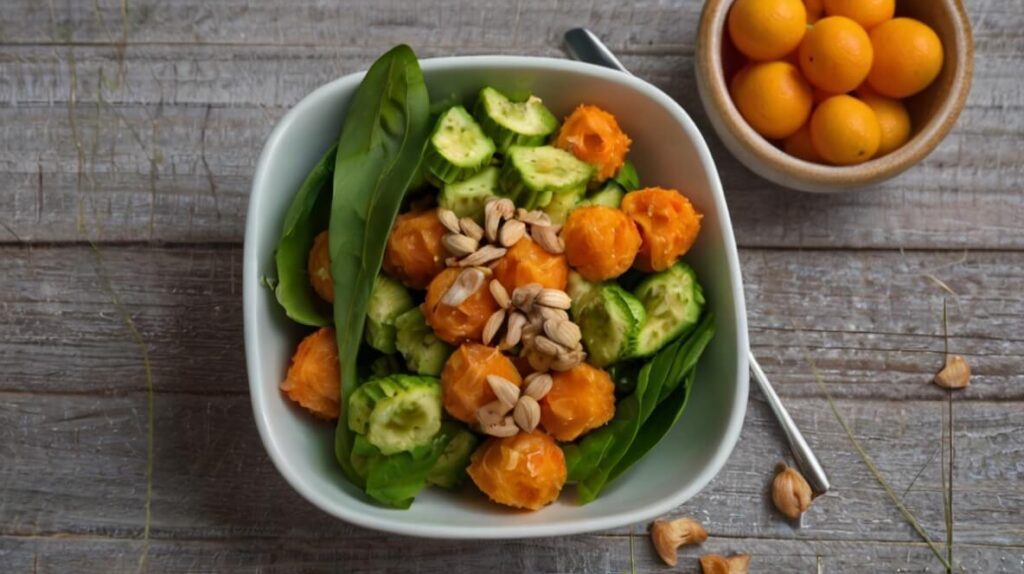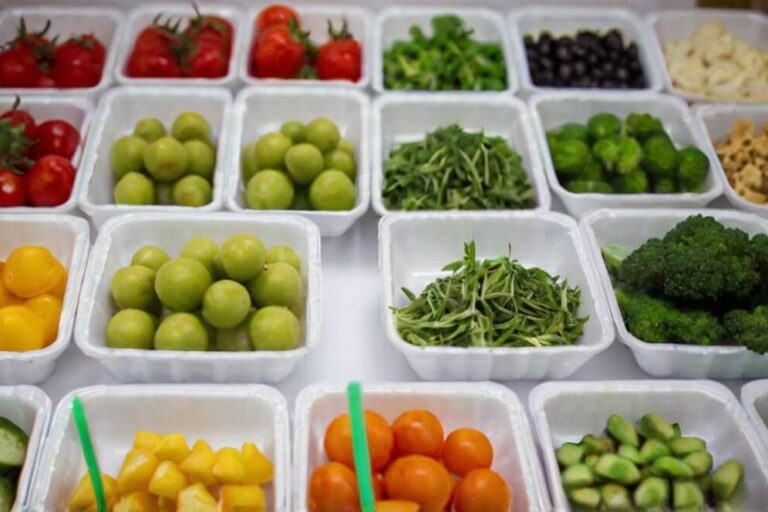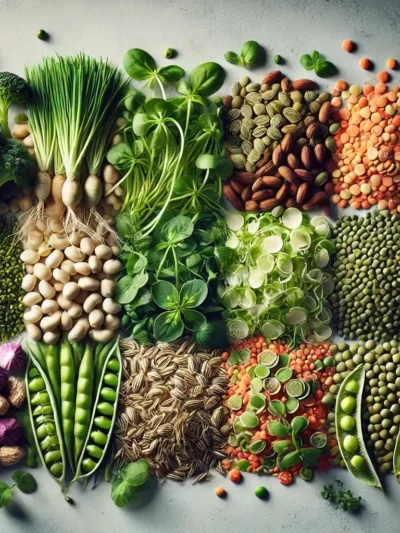Adopt a food A healthy diet is essential to achieving and maintaining an ideal weight in a sustainable and health-beneficial way. One of the pillars of this journey is understanding the importance of macronutrients—proteins, carbohydrates and fats—and how they influence how our bodies function.
This guide provides a comprehensive overview of how these nutrients are good for your well-being, as well as practical tips for planning balanced, Chinese meals.
Discover how to prepare nutritious meals, control portions, deal with emotional hunger and cook quickly and easily, transforming healthy eating into a pleasurable and accessible lifestyle.
Understanding macronutrients and their functions:
To achieve your weight loss goals in a healthy and sustainable way, it is essential to understand how macronutrients (proteins, carbohydrates and fats) work in your body.
- Proteins: In addition to being the building blocks of muscle, proteins increase the feeling of satiety, accelerate the metabolism and help preserve muscle mass during the weight loss process. Rich sources of protein include lean meats (grilled chicken, baked fish), boiled eggs, legumes (lentils, chickpeas), tofu, plain Greek yogurt and low-fat cheeses like ricotta.
- Carbohydrates: They provide the energy needed for our daily activities. Complex carbohydrates, found in whole foods, release energy gradually, avoiding insulin spikes and promoting a longer-lasting feeling of satiety. Choose sources such as brown rice, wholemeal bread with seeds, sweet potatoes, quinoa, oats and whole grain pasta.
- Fats: Essential for several functions of the organism, healthy fats help control appetite, absorb vitamins and keep metabolism functioning properly. Include foods such as extra virgin olive oil, avocado, nuts (chestnuts, almonds) and seeds (flaxseed, chia) in your diet.
- What macros are suitable for weight loss? – This EatingWell article details the importance of macronutrients in weight loss and discusses how macronutrient distribution can impact diet success, although a calorie deficit is key
( EatingWell ) .
Assembling the perfect dish:

To ensure your meals are balanced and nutritious, follow the divided plate rule:
- Half of the plate: Prioritize colorful fruits, vegetables, and greens. Vary the colors to ensure you get different vitamins and minerals. Try colorful salads with different types of leaves, raw and cooked vegetables, and add fruits like apples, pears, or strawberries for a sweet and refreshing touch.
- A quarter of the plate: Include a portion of lean protein. Try different preparations, such as grilling, baking, or steaming. In addition to the options already mentioned, you can include lean meats such as flank steak or filet mignon, as well as seafood such as shrimp and salmon.
- A quarter of the plate: Top it off with a whole-grain carbohydrate. Pair it with vegetables to increase the volume of your meal and your fiber intake. Try brown rice with steamed broccoli, whole-grain pasta with homemade tomato sauce and chopped vegetables, or baked sweet potatoes with herbs.
Practical tips for everyday life:
- Plan your weekly menu: Prepare a plan in advance, including all meals and snacks. Use apps or spreadsheets to organize your ideas and have an overview of your food plan for the week.
- Cook at home: Prepare your own meals using fresh, healthy ingredients. Experiment with new recipes and seasonings to make your meals more flavorful and interesting.
- Read food labels: Pay attention to the amount of sodium, added sugars and saturated fats. Choose foods with simpler labels and natural ingredients. Avoid processed and ultra-processed foods, which are generally rich in additives and have low nutritional value.
- Drink plenty of water: Water is essential for the proper functioning of the body and helps control appetite. Carry a bottle with you to stay hydrated throughout the day.
- Keep healthy snacks on hand: Chopped fruit with natural yogurt, homemade whole grain cereal bars, nuts and seeds are great options to avoid hunger between meals.
- Vary your meals: Try new recipes and food combinations to avoid monotony and keep eating enjoyable. Explore different cuisines and cultures to discover new flavors and ingredients.
- Cook in appropriate portions: Use smaller plates and serve yourself in controlled portions. This helps you have a more realistic idea of portion sizes and prevents overeating.
- Chew slowly: This helps increase the feeling of fullness and allows you to better enjoy the flavors of your food. It also allows your body to register the feeling of fullness before you overeat.
- Do physical activity regularly: The practice of physical exercises It helps with weight loss, improves health and increases energy. Find activities that you enjoy and practice regularly, such as walking, running, dancing or playing a sport.
- Look for a nutritionist: A qualified professional can help you create a personalized eating plan and support you throughout the weight loss process. They can guide you on the best food choices for your profile and help you overcome difficulties.
Remember:
- Weight loss is a gradual process: Be patient and persistent. Celebrate each small achievement and don’t get discouraged by results that take a long time to appear.
- Listen to your body: Eat when you are hungry and stop when you feel full. Avoid eating out of emotion or boredom.
- Seek support: Share your goals with friends and family and ask for help when you need it. Having the support of loved ones can motivate you and help you stay focused.
- Make the process a pleasurable journey: Explore new flavors, cook with friends and family, and transform food into a moment of pleasure and connection.
Remember: healthy eating is a lifestyle! By adopting healthy eating habits, you will be investing in your long-term health and well-being.

Detailed shopping list
- Organized by category: fruits, vegetables, meats, grains, dairy products, etc.
- Quantities: Indicating the appropriate portions for each meal.
- Brand suggestions: If you prefer, I can recommend healthier and more nutritious food brands.
Varied weekly menu
- Breakfast: Nutritious and energetic options to start the day on the right foot.
- Lunch and dinner: Balanced meals with protein, complex carbohydrates and a variety of vegetables.
- Snacks: Healthy options to control hunger between meals and avoid overeating.
- Practical and tasty recipes: So you don't get tired of always eating the same thing.
Tips for eating out
- How to choose the healthiest dishes: Analyze the menu, prioritize fresh and grilled foods, avoid fried foods and industrial sauces.
- Healthy options in different types of restaurants: Fast food, traditional restaurants, snack bars, etc.
- How to make healthier orders: Order smaller portions, replace high-calorie side dishes with healthier options, etc.
Recipes for all occasions
- Breakfast: Omelets, whole wheat pancakes, smoothies, yogurt with fruit and granola.
- Lunch and dinner: Salads, soups, grilled meats, baked fish, steamed vegetables, brown rice, quinoa.
- Snacks: Fruits, yogurt, nuts, seeds, homemade cereal bars.
- Special recipes: For parties, birthdays and other occasions.
Ingredient Substitutions
- How to make your favorite recipes healthier: Swap refined ingredients for whole ingredients, reduce sugar and fat consumption, use natural seasonings, etc.
- Substitution tables: To make your life in the kitchen easier.
Tips for Cooking Quickly and Practically
With busy lives, cooking healthy, tasty meals can seem like a challenge. But with a little planning and organization, you can prepare nutritious meals in no time.
- Prepare meals in advance: Cook an extra portion for dinner and save it for lunch the next day. Freezing soups, cooked vegetables, and lean meats is also a great option.
- Use pre-cut foods: Pre-cut fruits, vegetables and greens make meal preparation easier.
- Invest in practical utensils: A pressure cooker, air fryer or food processor can speed up meal preparation.
- Have an organized pantry: Keep non-perishable foods such as grains, legumes, oilseeds and spices on hand.
- Explore simple recipes: There are several quick and easy recipes available online. Look for recipes that use few ingredients and can be made in a single pan.
How to Control Portions

Portion control is essential to achieving your weight loss goals and maintaining a healthy diet.
- Use smaller plates: By serving food on smaller plates, you will feel like you are eating more than you actually are.
- Read food labels: Pay attention to the portions indicated on food labels and serve yourself according to the recommendations.
- Chew slowly: By chewing slowly, you give your brain time to register the feeling of fullness, preventing you from overeating.
- Divide meals into several small portions: Instead of eating three large meals a day, divide your diet into five or six small meals.
- Use measures: Use cups, tablespoons and scales to measure food, especially in the beginning.
How to Deal with Emotional Hunger
Emotional hunger is hunger that arises for emotional reasons, such as anxiety, stress or sadness. To deal with it, you can:
- Identify the triggers: Pay attention to the situations in which you tend to eat emotionally.
- Search for other activities: When you feel like eating emotionally, try to distract yourself with other activities, such as reading a book, listening to music or exercising. exercises physical.
- Talk to someone: Venting to a friend, family member or professional can help you deal with your emotions in a healthier way.
- Practice relaxation techniques: Meditation, yoga, and deep breathing can help reduce stress and anxiety.
- Keep a food diary: Write down everything you eat and how you feel before, during, and after meals. This can help you identify patterns and better understand your eating habits.
Remember: It is important to be patient and persistent. Changing eating habits takes time and dedication. If you find it difficult to follow your eating plan, seek out a nutritionist to help you.
| Question | Response |
|---|---|
| What are macronutrients? | Macronutrients are nutrients needed in large amounts to provide energy and support bodily functions. They include proteins, carbohydrates, and fats. |
| What is the role of proteins in the diet? | Protein helps build and repair muscles, increases feelings of fullness, and helps preserve muscle mass during weight loss. |
| Why are carbohydrates important? | Carbohydrates provide energy for the body. Choosing complex carbohydrates, such as whole grains, helps maintain stable energy levels and prolongs satiety. |
| What are the best sources of healthy fats? | Healthy fats can be found in foods such as extra virgin olive oil, avocado, nuts and seeds. They help with vitamin absorption and appetite control. |
| How to put together a balanced plate? | Follow the divided plate rule: half fruits, vegetables and greens, one quarter lean proteins and one quarter whole grain carbohydrates. |
| How important is meal planning? | Meal planning helps ensure a balanced diet, saves time and money, and avoids unhealthy food choices when you're on the go. |
| How can I control the portions of my meals? | Use smaller plates, read food labels, chew slowly, and divide meals into smaller portions. Measuring food can also help. |
| What is emotional hunger and how can I deal with it? | Emotional hunger is the desire to eat for reasons unrelated to physical hunger, such as stress or sadness. To deal with it, identify triggers, seek distractions, and practice relaxation techniques. |
| What are the best strategies for cooking meals quickly? | Prepare meals in advance, use pre-cut foods and convenient utensils, and keep an organized pantry with non-perishable foods. |
| How can I make healthy choices when eating out? | Analyze the menu, choose fresh and grilled foods, avoid fried foods and industrial sauces, and order smaller portions or replace high-calorie sides. |
Quick answers to common questions about meal planning and nutrition.









